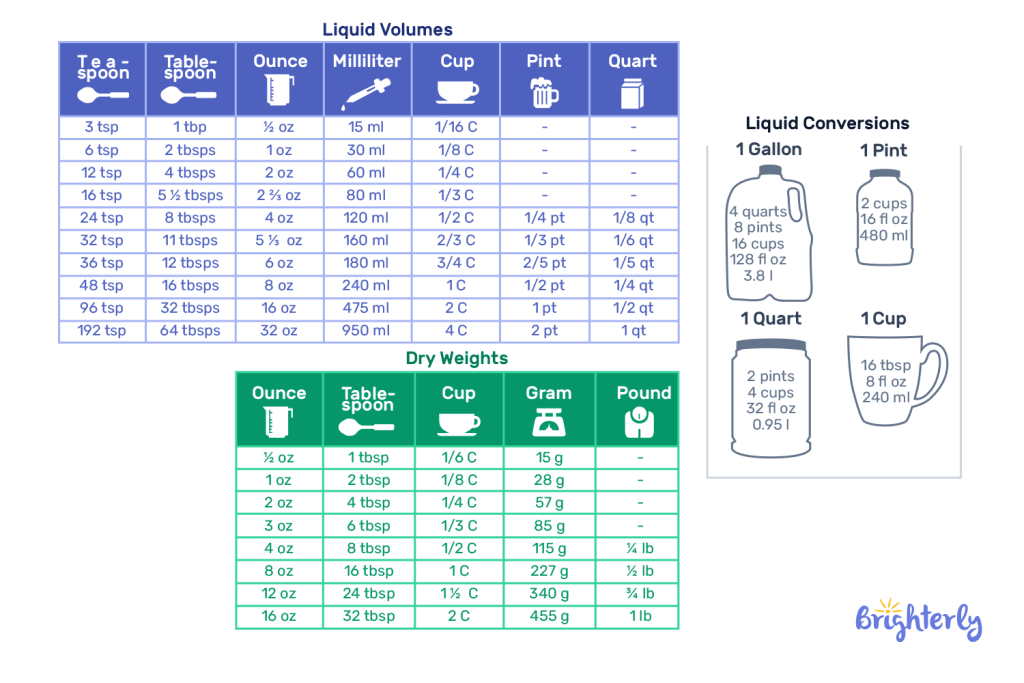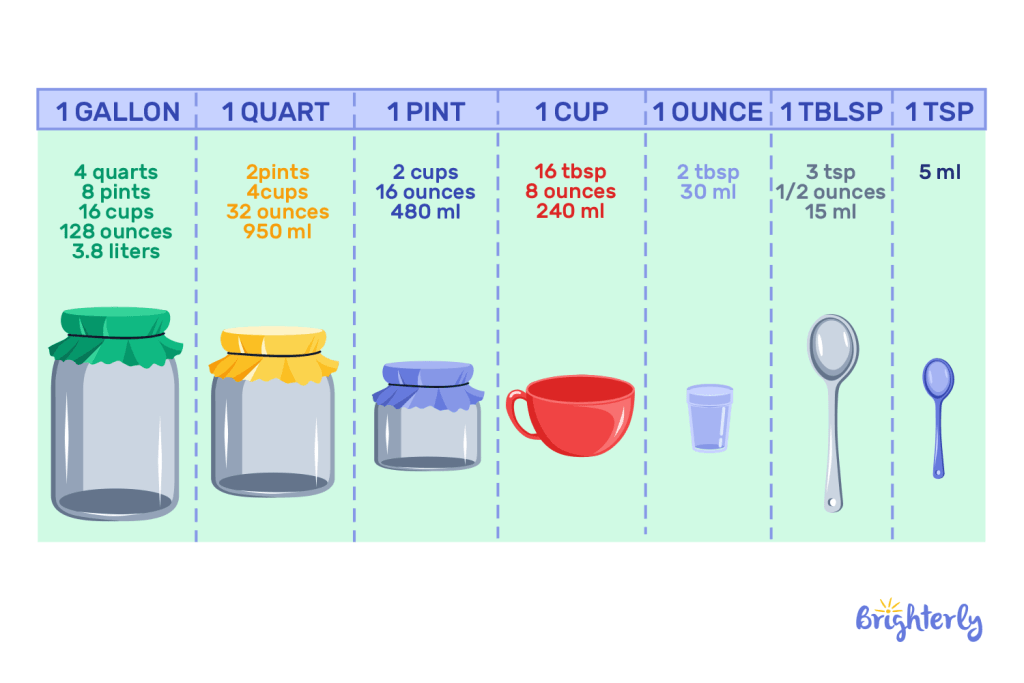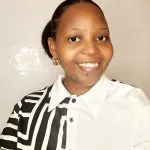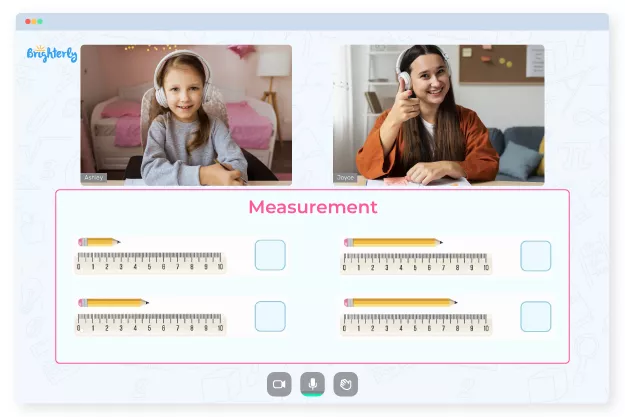Liquid Measurement Chart – Definition with Examples
reviewed by Mary Grace Carlos
Updated on October 28, 2025
Here’s one more valuable piece of knowledge from Brighterly? Today, we’re going to explore the liquid measurement chart, a useful tool that will help you easily convert between different units of liquid measure.
Even in your daily life, you might find yourself needing to convert from liters to ounces, for example, and having a chart will help you do this quickly and easily. This knowledge-sharing review will cover what a liquid measurement chart is, different unit conversions, and provide a liquid measures list. We also share practice problems so you can start working this out for yourself.
Liquid measurement chart
A liquid measurement chart is an extremely handy resource that shows you how to convert between different liquid units of measurement at a glance. You can use this chart for a number of purposes, including helping you convert cooking measurements, in a science experiment in a lab, or in your math class.
This chart uses visuals to help you easily understand how many cups fit into a gallon, for example, or how to convert milliliters to ounces.

Unit conversion
Unit conversion is the task that the liquid measurement conversion chart helps us with. Whether you’re cooking or experimenting in school, unit conversion is an essential skill to learn.
But with so many different measurements – and even different unit systems, like the metric and imperial systems – it can be hard to remember. That’s where the liquid measurement chart comes in!
Units of liquid measurement
There are lots of units of liquid measurement you can encounter in life. First of all, you’ll most commonly come across imperial units of liquid measurements, because we use the imperial system here in the US. Imperial measurements include:
- Teaspoons
- Tablespoons
- Fluid ounces
- Cups
- US liquid pint
- Quarts
- Gallons

You may also need to convert measurements from the metric system, which is used in most countries outside the US. The skill is especially valuable if you are converting from an online recipe, for example. Metric measurement of liquid volumes includes:
- Milliliters
- Centiliters
- Liters
- Imperial pints
You might have noticed that there are two different measurements of pints. The US liquid pint (16 fluid ounces) is smaller than the imperial pint (568 milliliters) and is used in places like the UK.
Solved examples on liquid measurement chart
To help you understand how to tackle math questions using your unit of liquid measurement chart, have a look at some solved examples.
Solved math task 1
You’re making a recipe that requires ¼ gallon of milk, but your jug is measured in pints. How many pints do you need for this recipe?
Answer
| 2 pints. |
Using your measurement chart liquid, you’ll see that there are 8 pints in a gallon. So, to work out how many pints you need, divide 8 by 4 (which divides it into quarters).
8 pints ÷ 4 = 2 pints.
Solved math task 2
You’re given a science experiment at school that requires 474 milliliters of water. However, your beaker measures in cups. How many cups would you need?
Answer
| 2 cups. |
Now, you’ll need to convert metric system liquid measurements using your liquid measurement chart. 1 cup is equivalent to 236.58824 milliliters. 2 cups is therefore 473.17648, which is close enough to 473 milliliters.
Measuring Liquids Worksheet
Liquid Measuring Worksheets
Practice problems on liquid measurement chart
Now, it’s time to try out some math questions yourself. Using your liquid measurement chart, convert the following measurements of liquid:
- You’re cooking a recipe that calls for 200 milliliters of milk. How much is this in fluid ounces?
- You have a water bottle that holds half a gallon of water. How much is this in quarts?
- You’re making lemonade, and your recipe requires 4 quarts of water. If you’re using a gallon jug, how many jugs is that?
- You need a liter of a specific chemical for an experiment in science class. Using your measuring jug that measures in cups, how many cups do you need to measure out?
Conclusion
Now that you know all about the liquid measurement chart for kids, you can tackle any liquid measurement conversion problem that comes your way. This handy tool will give you the confidence to convert measurements with ease, no matter where you are or what the requirement is.
Frequently asked questions on liquid measurement chart
What is the purpose of a liquid measurement chart?
The purpose of a liquid measurement chart is to show you all the different liquid units of measure and how to convert between them. It’ll show you how to convert measurements in the same system, like ounces and quarts. It also works across different systems, like gallons to liters.
What does unit conversion mean?
Unit conversion means you work out how much of one unit is required in a different unit. For example, if you have 4 cups and need to know the equivalent in ounces, you need to convert the measurement from cups to ounces, which is 8.
What are the most common units of liquid measurement?
In the US, we use the imperial system, so the most common units of liquid volume are teaspoons, tablespoons, ounces, cups, pints, quarts, and gallons. You may also come across liters and milliliters, which are metric system liquid measurements.
How does the commutative property apply to liquid measurements?
The commutative property applies to liquid measurements when you add volumes, meaning that the answer is the same no matter the order. If you add 1 gallon of water to 2 gallons, you get 3 gallons. Equally, if you add 2 gallons to 1 gallon, you still get 3 gallons.






